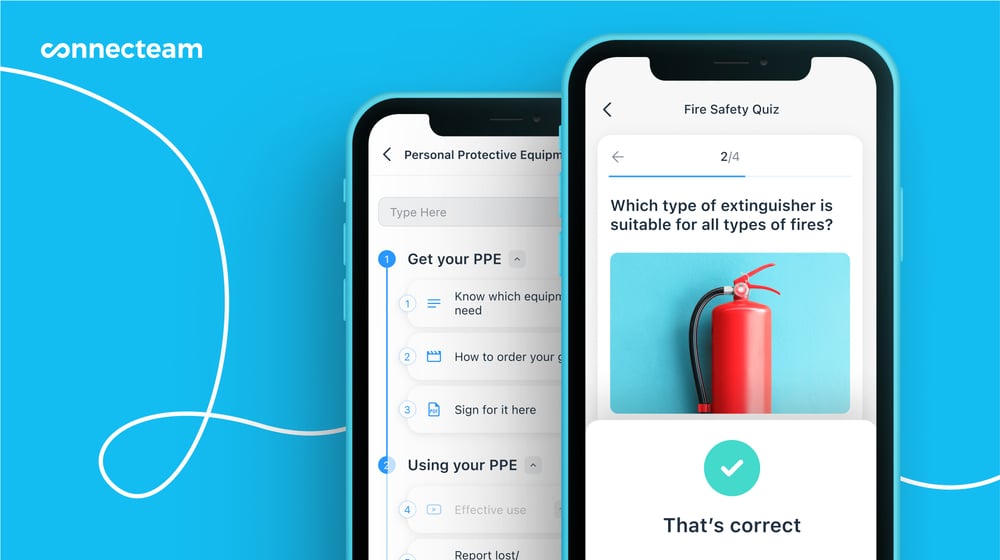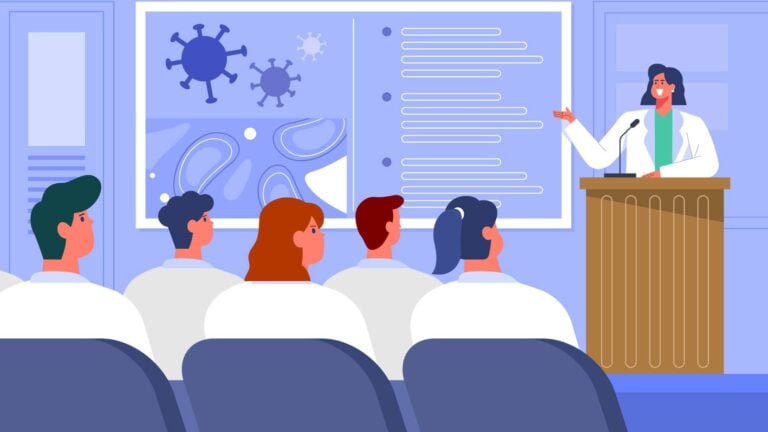Healthcare employee training is essential for maintaining safety and compliance. We discuss 8 proven strategies to improve your staff’s skills.
In the healthcare industry, continuous training is crucial for keeping staff updated with new technologies, evolving patient expectations, complex regulations, and more.
Inadequate training can lead to reduced patient satisfaction, higher error rates, and compliance failures. Effective training minimizes these risks and enhances patient care quality.
Key Takeaways
- The benefits of regular training include improved patient outcomes, enhanced staff efficiency, enhanced compliance, and reduced operational errors.
- Some best practices for effective employee healthcare training include conducting comprehensive needs assessments, aligning training with organizational goals, using blending learning methods, and incorporating technology topics.
- Ongoing training efforts should focus on developing soft skills, providing compliance training, offering mentoring and coaching, and evaluating the effectiveness of training programs.
Why Is Employee Training Important in Healthcare?
Healthcare staff training is vital for ensuring patient safety, regulatory compliance, and keeping pace with medical advancements. Continuous training helps healthcare professionals adapt to evolving technologies and patient needs, ensuring they are always equipped with the latest skills and knowledge. It enhances patient outcomes, increases operational efficiency, and helps your team avoid costly errors and compliance issues.
Benefits of effective healthcare employee training include:
- Enhanced patient care and satisfaction.
- Increased operational efficiency and smoother workflows.
- Compliance with healthcare laws, reducing legal risks.
- Improved employee morale and retention.
- Adaptability to new technologies and medical advancements.
8 Best Practices for Healthcare Employee Training
Here are 8 best practices for optimizing employee training in healthcare.
Conduct comprehensive training needs assessment
Start every training program with a needs assessment to identify your team’s knowledge and skill gaps. This helps make sure your training is focused, relevant, and aligns with your goals and regulations. Here’s how:
- Evaluate your staff’s clinical competencies and operational skills through direct observations, patient feedback, and performance reviews. Use this data to identify patterns or specific areas that need improvement. For example, discovering a recurring issue in medication management may indicate the need for enhanced pharmacological training.
- Check for new regulations or industry guidelines that might require updating your staff’s knowledge and practices. Regularly consult resources like the Centers for Medicare & Medicaid Services (CMS) or local health department websites for updates. Use this information to tailor and prioritize training areas to keep your team compliant and informed.
- Engage subject matter experts and frontline employees in the assessment process to help accurately identify skill gaps and training needs. For example, experienced nurses could provide insights into common challenges in patient handling, highlighting areas where training is most needed.
- Don’t overlook the training needs of your new hires, specifically focusing on new employee healthcare compliance training as part of their comprehensive onboarding. For example, new hires should receive detailed training materials that cover everything from facility safety protocols and emergency procedures to the electronic health records (EHR) system your facility uses.
- Don’t overlook your non-clinical staff—from administrative personnel to janitorial teams. Their roles are crucial in maintaining the smooth operation of healthcare facilities.
Align identified needs with specific training topics
Next, you must align the training needs you’ve identified with specific training topics that directly address these needs. For example, to address the need to improve patient satisfaction, focus on training that enhances interpersonal communication and patient interaction skills.
Here are some more examples:
| Identified training needs | Targeted training topic |
| Improve patient safety | Error prevention protocols, safe medication practices |
| Enhance patient satisfaction | Communication and customer service skills |
| Reduce Healthcare-associated Infections (HAIs) | Hygiene and sterilization techniques |
| Streamline operations | Proficiency in electronic health records (EHR) systems |
| Boost team collaboration | Teamwork and conflict resolution methods |
| Enhance diagnostic accuracy | Updated diagnostic criteria training |
Design effective healthcare employee training programs using blended learning methods
Effective training healthcare programs keep your workforce skilled and ready for diverse challenges. A good program addresses key knowledge and skills, meets different learning needs, and adapts to the changing healthcare environment.
Blended learning methods are effective as they combine online and traditional classroom methods. This approach provides flexible, personalized learning experiences that engage participants and suit various learning styles.
Start by incorporating multimodal learning approaches, which involve using various modes or methods to teach information. This can enhance understanding and retention by engaging different learning styles. Here are some learning approaches you might blend:
- Lectures and webinars to establish foundational knowledge.
- Interactive workshops for applying concepts in real-world settings.
- Visual aids like diagrams and infographics to reinforce learning.
For instance, a combination of live demonstrations of clinical procedures followed by virtual reality (VR) simulations can create immersive, informative learning experiences.
Here are some other learning methods you might consider.
Microlearning
This method involves delivering content in short, focused bursts through modules, quizzes, and flashcards. It’s ideal for on-the-go learning. For example, a series of 5-minute videos on patient safety protocols or quick quizzes on drug interactions can be very effective.
Daily microlearning content delivered via apps like Connecteam can fit seamlessly into the busy schedules of health professionals, making continuous education more manageable and less intrusive.

Hands-on and simulation-based learning
This approach uses simulations to mimic real-life medical scenarios that require critical thinking and problem-solving. This method is beneficial for training on emergency response, surgical procedures, or even routine but critical tasks like sterile technique. It’s also great for new employee healthcare compliance training.
Case-based learning
This method uses actual case studies to examine various patient care strategies, boosting problem-solving abilities and teamwork. For example, a discussion on managing diabetic ketoacidosis might include nurses, doctors, and pharmacists, each offering their insights on effective patient management.
Interprofessional education (IPE)
This approach involves training sessions where multiple disciplines collaborate and learn together. For example, nurses, doctors, and administrative staff might participate in joint sessions on handling medical emergencies or improving patient flow.
Feedback-driven learning
Participants get immediate and constructive feedback from peers and instructors, which improves the learning experience.
Did You Know?
A healthcare learning management system (LMS) improves your training process with features for creating engaging content, tracking learner progress, and offering customized learning paths.
Train healthcare professionals on the use of technology
As technology becomes increasingly integral to healthcare, training employees on using advanced systems like electronic health records (EHR), practice management software, telehealth platforms, and more is critical. This training boosts efficiency and ensures accuracy and employee compliance in patient care and administrative tasks. Some examples include:
- EHR: Provide in-depth, role-specific training so your clinical and administrative staff can adeptly manage data entry and retrieval and maintain compliance with privacy regulations.
- Practice management software: Focus training on using software features to handle scheduling, billing, and other administrative functions efficiently.
- Telehealth platforms: Equip your team with the skills to manage telehealth technologies, ensuring they can deliver high-quality patient care remotely while maintaining a personal touch.
- Medical coding and billing software: Offer detailed training on current coding standards and practices, using real-life scenarios to ensure accuracy and compliance. This training is beneficial for non-clinical or administrative staff to enhance their efficiency.
- Data analytics tools: Teach your staff to interpret and apply data insights to improve clinical decisions and patient outcomes.
Pro Tip
Use Connecteam’s customizable training features to build comprehensive training modules for each type of software. Use multimedia resources like video tutorials and step-by-step guides with images to enhance learning.
Provide mandatory compliance and regulatory training
Compliance and regulatory training is mandatory for healthcare organizations. Neglecting these critical requirements can lead to severe consequences, including legal penalties, financial losses, and significant damage to your organization’s reputation.
It’s essential to provide comprehensive new employee healthcare compliance training to ensure all newcomers are fully versed in your organization’s standards from the start. Also, ensure seasoned staff receive continuous updates on regulatory changes to maintain informed compliance.
Provide regular training sessions using compliance training software that covers all mandatory compliance and regulatory standards applicable to your healthcare setting. These should address all aspects of legal and ethical conduct required by law.
Also, regularly assess compliance training effectiveness and maintain detailed records to monitor employee comprehension and compliance during audits.
Mandatory compliance training includes:
- HIPAA compliance: Ensuring privacy and security of patient health information (PHI).
- OSHA trainings (Occupational Safety and Health Administration): Promoting a safe work environment and preventing workplace injuries.
- CMS compliance: Adhering to standards set by the Centers for Medicare & Medicaid Services.
- Fraud, waste, and abuse: Educating on recognizing and preventing unethical practices.
- Anti-harassment training: Creating a respectful and safe workplace for all employees.
- Regulatory training: Understanding and complying with broader healthcare regulations.
- Information security training: Protecting sensitive data and information systems.
Like clinical staff, non-clinical personnel must understand the healthcare regulations and compliance requirements that affect their work. For example, training on HIPAA compliance for administrative staff who handle patient data or OSHA standards for maintenance and janitorial staff.
Pro Tip
Use Connecteam compliance software to manage your compliance training effectively. Schedule training sessions, send reminders, track completion rates, and monitor certification expirations. Plus, Connecteam is HIPAA compliant, ensuring the privacy and security of PHI.
Learn more about how Connecteam can help you remain compliant.
Focus on soft skills
While technical skills and compliance are critical, don’t overlook the human element. Soft skills are crucial for fostering a supportive and effective healthcare environment. Here are specific soft skills to focus on in your healthcare employee training programs:
- Communication skills: Train staff to convey complex medical information clearly and empathetically, using role-playing scenarios to practice verbal and non-verbal communication.
- Empathy: Include workshops or VR simulations that allow staff to experience patients’ challenges, enhancing their ability to empathize.
- Team collaboration: Use team-building exercises and conflict resolution training to enhance understanding across different roles within the healthcare team.
- Problem-solving: Offer case studies and real-world problem-solving exercises to enhance quick thinking and effective decision-making in complex situations.
- Adaptability: Mimic scenarios like sudden patient flow to teach staff how to adjust quickly and effectively under pressure.
- Stress management: Provide training in mindfulness, relaxation exercises, and work-life balance strategies to help staff manage the high stress of healthcare environments.
- Resilience building: Conduct workshops focusing on building resilience, using real-life cases where resilience plays a key role in overcoming healthcare challenges.
- Customer service training: Non-clinical staff often interact with patients and visitors under stressful conditions. Training in customer service can enhance the patient experience significantly.
Evaluate training effectiveness
To ensure that your healthcare employee training programs are comprehensive and effective, you must evaluate their impact regularly. This involves measuring how well the training covers the intended training topics, meets your pre-set metrics, and translates into practical, on-the-job improvements. Here’s how to approach this:
- Set clear metrics: Before the training begins, define what success looks like. Are you aiming to reduce error rates, improve patient satisfaction scores, or enhance compliance adherence? Establishing clear metrics allows you to measure the direct impact of training.
- Gather feedback from staff and patients: Use surveys and discussions to understand how training has affected staff performance and patient satisfaction. Ask about changes in patient interactions, procedural compliance, and any recommended improvements.
- Observe and monitor: Observe staff in clinical settings to see how they apply new skills when interacting with patients or managing emergencies.
- Assess and test: Use targeted assessments that measure both knowledge retention and practical application, such as simulations of patient care scenarios or role-playing scenarios involving patient communication.
- Analyze the long-term impact: Track longer-term indicators such as patient recovery rates, the frequency of readmissions, or compliance audit results, which can take time to show improvements but are vital for assessing the real-world impact of training.
- Cost-benefit analysis: Compare the costs involved in conducting the training (such as time spent away from patient care) against measurable benefits like decreased malpractice claims or lower turnover rates among trained staff.
- Continuous improvement: Use all the data and feedback to refine your training approaches. Aim for a cycle of improvement that makes each session more adapted to the needs of your healthcare environment.
Offer mentoring and coaching
Mentoring and coaching are crucial for providing personalized guidance and helping both clinical and non-clinical staff learn and apply skills effectively in their roles.
Mentoring involves experienced personnel, such as seasoned nurses or senior physicians for clinical staff, and experienced administrators for non-clinical roles, offering development guidance and hands-on support. Mentoring focuses on career development, helping staff navigate opportunities, and build a supportive network within the healthcare environment.
In contrast, coaching is often delivered by trained coaches or supervisors who specialize in bridging the gap between theoretical knowledge and practical application. It applies in both clinical settings, like operating rooms, and non-clinical areas, such as administrative tasks, enhancing precision and building confidence.
Moreover, continuous feedback from mentoring and coaching is essential for ongoing improvement. This personalized feedback is crucial for making real-time adjustments and adapting to the evolving demands of healthcare.
Empower Your Healthcare Team With Continuous Training
Ongoing training and education are critical in healthcare to uphold high patient care standards and adapt to new technologies and regulations.
By properly assessing training needs, implementing blended learning techniques, and ensuring rigorous compliance training, you can effectively equip your team to meet these challenges. Plus, fostering soft skills and implementing mentoring and coaching enhances practical skills and professional development.
By regularly evaluating the effectiveness of training, you can make sure that it continues to meet its goals, promoting a culture of continuous improvement and increasing employee retention and satisfaction.
Connecteam’s healthcare training app can improve your training programs with interactive courses, progress tracking, and quizzes. Additionally, Connecteam provides staff scheduling, communication tools, compliance management, and so much more.


